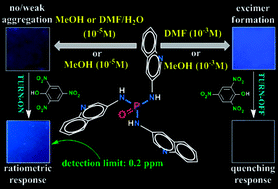Concentration dependent ratiometric turn-on selective fluorescence detection of picric acid in aqueous and non-aqueous media†
Abstract
A phosphorictriamide scaffold, [(NHAQ)3P![[double bond, length as m-dash]](https://www.rsc.org/images/entities/char_e001.gif) O] (TAQP), which has an electron-rich aminoquinoline (AQ) chromophore, is shown to exhibit a ratiometric turn-on response for picric acid (PA) at low (1 × 10−5 M) concentration via a proton-transfer pathway. However, due to the presence of strong H-bonding and π⋯π interactions, at higher concentrations (1 × 10−3 M), it exhibits only a luminescence quenching behaviour for PA. These effects can be observed in both protic and non-protic systems. The detection limit for this aqueous phase turn-on sensing was found to be 0.2 ppm.
O] (TAQP), which has an electron-rich aminoquinoline (AQ) chromophore, is shown to exhibit a ratiometric turn-on response for picric acid (PA) at low (1 × 10−5 M) concentration via a proton-transfer pathway. However, due to the presence of strong H-bonding and π⋯π interactions, at higher concentrations (1 × 10−3 M), it exhibits only a luminescence quenching behaviour for PA. These effects can be observed in both protic and non-protic systems. The detection limit for this aqueous phase turn-on sensing was found to be 0.2 ppm.


 Please wait while we load your content...
Please wait while we load your content...